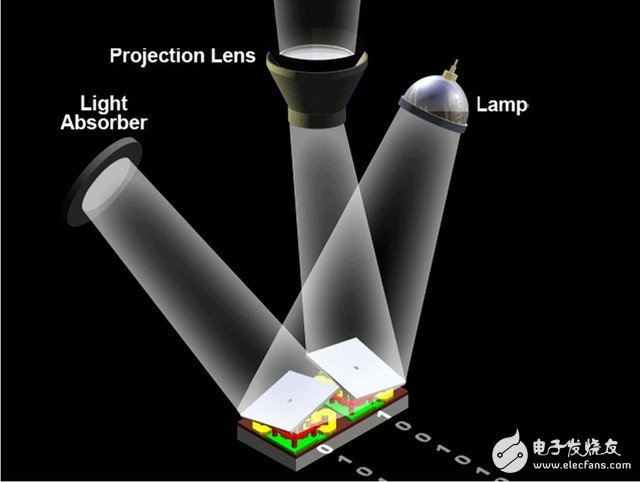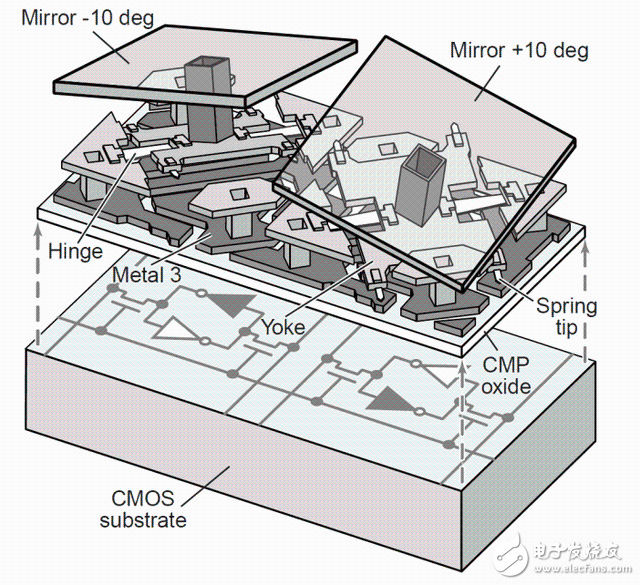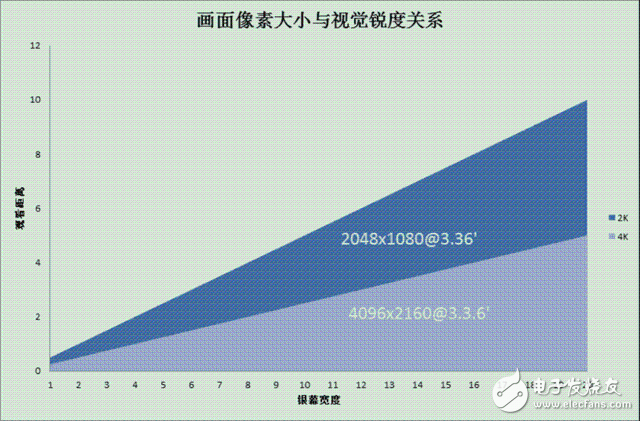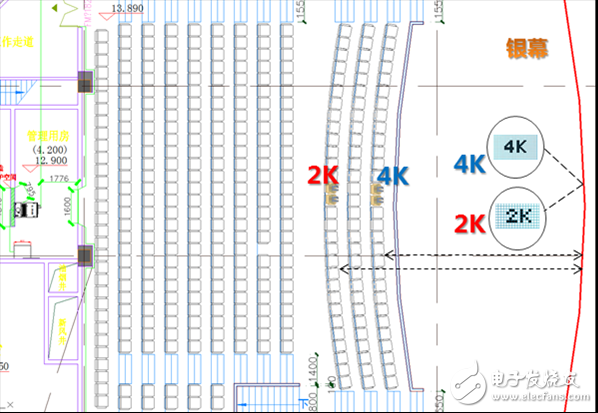In recent years, with the development of display technology, 4K technology is no longer a new name. 4K technology is constantly enriched and full of all aspects of our lives. In the recent hot film industry, in addition to a box office, it has continuously hit a new high. In addition to the large-scale domestic and international films, the cinema's quality requirements for the screening of the screen and the viewer's viewing experience are constantly improving. In order to keep pace with the development of the film market, NEC, the leader and developer of projection technology development, will also be launched in 2016 with 3 chips DL PCinema? 1.38 inch DC4K three-color laser digital projector NC3540LS-1+. This makes the NEC tri-color laser projector add a 4K tri-color laser product line while having a 2K tri-color laser product line.
What is the 4K technology?In order to understand the 4K technology, we first say the definition of 4K. 4K refers to the number of pixels arranged in the horizontal and vertical directions. Everyone knows that the traditional HD picture resolution is 1920x1080, and the film industry uses 2048x1080 resolution. The above two resolutions are called 2K resolution. So for the 4K technology engineering field is 3840x2160, the film industry 4096x2160, both of which we can call 4K resolution, of course, in addition to the resolution and frame rate, color sampling rate, color depth, etc. will determine the final display technology form, these The parameters are not discussed in this article.
According to the application link classification, 4K technology includes 4K source production, 4K playback equipment, 4K signal transmission, 4K display technology. Here we will have a certain understanding of 4K display technology.
Second, 4K display technologyAs the display technology of the projector, there are mainly three mainstream types, LCD (liquid crystal panel display technology), LCOS (single crystal silicon reflective liquid crystal display technology), and DLP (digital light processing display technology). Currently used in digital cinema projection technology is the most used DLP technology, DLP technology developer is TI (Texas Instruments), NEC company is focused on providing professional display solutions for the industry, NEC is not only TI (Texas Instruments) company Worldwide, it is authorized to produce one of the three DLP digital projectors, and has a diverse range of DLP projectors in engineering, business, education, and home. For NEC's 4K tri-color laser projector NC3540LS-1+, three 1.38-inch DMD chips are used to display 4K images. The physical resolution of each chip is 4096x2160. The three chips are independently corresponding to one RGB color. One.
4KDLPCinema? The DMD chip in display technology has the unique advantages of other display technologies, which also make it suitable for many display applications such as high-brightness output, long-time use, and harsh operating environment. Let's take a look at each one below.
Support high brightnessIn recent years, the Chinese film market has flourished. According to the statistics of 2015, the number of new screens in China has reached 8035 in the middle of the year, and the total number of market screens has reached 31,600. The ensuing problem is that the density of the studios in the same area is getting bigger and bigger, the difference between the studios and the studios is getting smaller and the competition is getting more severe. Creating a distinctive cinema has become a new problem facing the studio. In order to increase the competitiveness of the studio, the size of the screen in the cinema is now polarized. The small screen below 10 meters corresponds to the small hall, the VIP hall, the couple hall, etc. These small cinemas have low investment costs and construction. The cycle is short, the layout is more flexible, and the theme style decoration style can also be added, so that the cinema revenue can be maximized under the premise of a certain degree of attendance. The large-size screen of 15-20 meters, the large-size screen is similar to the giant screen hall. Although the investment cost is large, the construction period is long, and the maintenance cost is high, the immersive feeling of the large-size picture, the shock of the immersive sound effect, and the high standard The quality of the picture is an advantage that the small theater cannot bring, so that the studio can get a very high profit from a large movie. In order to reflect the high quality of the screening on such a large screen, the studio must guarantee a certain screen brightness (such as 2D@14±3fL or L[1] recommended in the DCI specification), and the current domestic 3D source. The demand for playback is increasing rapidly. The construction standards and equipment configuration of all theaters in the cinema will be implemented in accordance with the 3D playback requirements. In addition, the environmental problems in the existing cinema studios are increasingly prominent. The brightness of the projector is greatly affected by dust. The current technology of 3D equipment. Still unable to provide sufficient light efficiency, low gain, the SARFT also issued a document some time ago to clarify that the studio should improve the quality of the show. Based on the above reasons, the studio generally chooses to output a projector with a higher brightness to ensure the brightness of the screen. The higher the brightness of the projector output, the higher the heat and light utilization requirements of the chip. The metal aluminum sheet used in the DMD chip uses different deflection angles to reflect light to different positions to achieve light and dark changes in the picture. The light utilization mode is total reflection display, so the light utilization rate is high, and it is precisely because most of the light is Reflected by the metal surface, the heat accumulation on the chip will become very small, coupled with efficient liquid cooling, so that the chip can maintain a good operating state in high brightness and high temperature environment. It is precisely because of this that the current mainstream high-lumen projectors (25,000 lumens or more) use almost all three DLP technologies. Figure 1 is a schematic diagram of the working principle of the DMD chip [1]

Generally, cinemas are for-profit organizations. Time is a profit for the studio. During the period of blockbusters or holiday holidays, the total time of a single movie in a movie studio can be as high as 15 hours a day. Some studios even launch midnight games. In this case, the device must be able to support continuous use for a long time. The DMD chip using the DLP technology projector first uses liquid cooling, and the liquid cooling system can accurately and effectively dissipate the heat source quickly and effectively. Secondly, each pixel of the DMD is a metal mirror (Mirror), and even used to realize the metal mirror (Mirror), the rotating hinge (Hinge), the structure is also an aluminum structure, these metal structures make the chip hardly subject to heat. And the effect of UV aging, DMD structure is shown in Figure 2 [2]. Finally, the DMD chip can achieve over 5,000 flips per second by using charge attraction and repulsion (the deflection time controlled by the pulse width is different from the gray scale), which makes it difficult for heat to accumulate on the chip for a long time. Many of the above advantages make DLP technology using DMD chip can support the long-term continuous use of the device. At present, the operating life of DMD chips in TI's DLP technology has reached 100,000 hours. There are still a large number of cinemas in the cinema still using the first generation of DLP digital cinema projectors 7-8 years ago.

Figure 2 Schematic diagram of DMD structure
The chip has good dustproof design, good heat dissipation and strong adaptability to the environment.Nowadays, the audience's requirements for the quality of the cinema are getting higher and higher. Even those who have never been exposed to technology will choose a better cinema in many studios. So for the studio, how to ensure better viewing performance after the device is running for a long time has become a particularly important issue. In fact, one of the biggest factors that darken the brightness of the screen is dust.
And it's usually due to the current worrying projection room environment. But from the chip's point of view, each DMD chip has a mature metal package structure, and the surface of the micromirror has a high temperature and high transmittance sealing glass. These seal designs and metal structures can make the DMD chip even in the In a bad environment, it can still guarantee a good service life. Figure 3 shows the appearance of the DMD chip
High market acceptance
Throughout the global projector industry, the use of DLP projectors has been involved in education, corporate government, home entertainment, large-scale entertainment, manufacturing, medical and many other fields, according to incomplete statistics, in 2015, more than 10,000 lumens of projectors worldwide 3 DLP technology projectors account for up to 80% of sales, and 3DLP projectors account for about 50% between 3,000 and 10,000 lumens. We are watching the film industry as of the end of 2015, according to incomplete statistics. The number of film machines using DLP technology in the Chinese film market with a market share of more than 30,000 screens is about 90%, and the number of film machines using non-DLP technology is less than 10%.
From the sales volume of display technology types, DLP technology is more suitable for high-end market with high lumens and more demanding application and application environments.
Third, 4K display technology can show more contentIn addition to the advantages of high brightness, long-term use, good dust-proof sealing and high market acceptance, the 4K display technology using DMD chip is far superior to the traditional 2K picture in 4K display.
Usually, if you want the display chip of the content display device to display more pixels, you must have more pixels. The pixels on each chip represent the smallest content unit in the picture content. The minimum pixel unit of the projector chip is the DMD chip. Each small micro mirror). Let's make a simple calculation. If the projector's chip is 2K, its horizontal and vertical pixels are 2048x1080. The total number of pixels that can be used to express the content of the display is 2048x1080=221.2 million.
If the projector's chip is 4K, its horizontal and vertical pixels will be 4096x2160, and the total number of pixels that can be used to express the display content is 4096x2160=88.47 million. This means that if the picture content is 4K source, and the amount of information displayed on the screen when playing with a 4K projector will be 4 times that of the 2K projector playing 2K picture information as shown in Figure 4.
Fourth, 4K display technology can make the picture more delicateMost of today's display technologies are designed based on the visual characteristics of the human eye. One of the most important human eye features, "visual sharpness", is often used together with the pixel size and viewing distance of the display to describe the human eye. Watch the delicateness of the picture. The size of the pixel generally depends on the size of the chip and the number of pixels. The visual acuity of the human eye (which can also be understood as the eyesight of the human eye) is usually related to individual differences and the age of the person. The viewing distance refers to the distance between the human eye and the viewed picture.
Let's first understand the concept of visual sharpness:The ability of the eye to distinguish details of the scene is called vision, also known as visual sharpness (VA). The physical distance between the photosensitive cells on the human retina determines the limit of the human eye's resolution. When imaging in the macula, the resolution reaches the highest 1' angle.
Usually when the angle of view is less than 1', the human eye cannot distinguish.
At the same time, when the brightness and contrast are too low, the visual acuity decreases (the sensitivity of the cone to the brightness is low, at which time the main rod cells act); when the brightness is too high, the visual sharpness does not increase. Instead, there will be glare, different colors have different effects on resolution, but lower than the effect of brightness on resolution (usually green contributes the most to the resolution of the human eye), the resolution of the human eye to the still picture. The ability to move pictures is higher (still picture 2-3', dynamic picture 3-4').

Figure 5D shows the picture height, d minimum cell height (pixel height), L viewing distance, φ picture height relative to the human eye, θ single pixel height relative to the human eye (arc).
I can see from the figure that when the visual acuity (visual power) of the human eye is a fixed value, the smaller the pixel size, the farther the viewing distance is, the lower the resolution of the human eye is to the pixel, and the larger the image size is. The closer the viewing distance is, the higher the resolution of the human eye to the pixel.
Then according to the principle of human eye characteristics above, this can be used to obtain a relationship between the viewing distance and the delicateness of the picture viewed by the human eye:
The current "Digital Film Giant Screen Cinema Technical Specifications" stipulates that the recent viewing distance is 0.5 times the screen width. If it is a 2K picture, the angle of each pixel relative to the human eye is 3.36', and the 4K picture can be calculated based on this basis. Figure 6 below.

The first screen screen of the same size of FIG. 6 reduces the pixel density of the pixel size, which makes the picture more delicate. Second, if the pixel size is the same, the viewing distance of the human eye can be made closer.
Five, 4K display technology can give viewers a better sense of visual immersionThe delicateness of the picture mentioned in the previous article determines the viewing distance of the viewer, because the human eye has another characteristic field of view, so that different viewing distances will affect the relative range of the field of view and the picture. Relationships, for example, due to the limited field of view of the human eye, the closer the viewing distance is, the stronger the sense of wrapping or the sense of presence felt by the human eye, and the farther the viewing distance is, the less obvious the feeling of wrapping or the sense of presence perceived by the human eye is. . We combine the delicateness of the above picture with the scope of the human eye, and Figure 7 illustrates the relationship between them.

If the display screen is 4K resolution, the appropriate reduction of the viewing distance can greatly increase the immersion of the human eye when viewing the screen, and at the same time, it does not produce a grainy feeling.
Six, 4K display technology applicationBased on the product technology advantages and ultimately serving the application principle of the terminal market, the advantages of 4K display technology, such as increased screen detail, improved image detail and enhanced immersion, have been well applied in many fields. Movie theaters and theme parks with large screens require multi-channel signals, large-screen command and monitoring for high-resolution display, research institutes, studios, etc. that require high information content or editing. In addition to the professional field, in order to meet the needs of the consumer industry, TI is also vigorously developing, miniaturized 4K display technology, reducing the volume and weight and cost, 4K technology is slowly entering the home entertainment industry, 4K technology will also be the future display An important trend in technology development.
Vertical-Cavity Surface-Emitting Lasers
Vertical-Cavity Surface-Emitting Lasers,Vertical External Cavity Surface Emitting Laser,Vertical Cavity Laser,Vertical Emitting Cavity Surface Laser
AcePhotonics Co.,Ltd. , https://www.cgphotonics.com